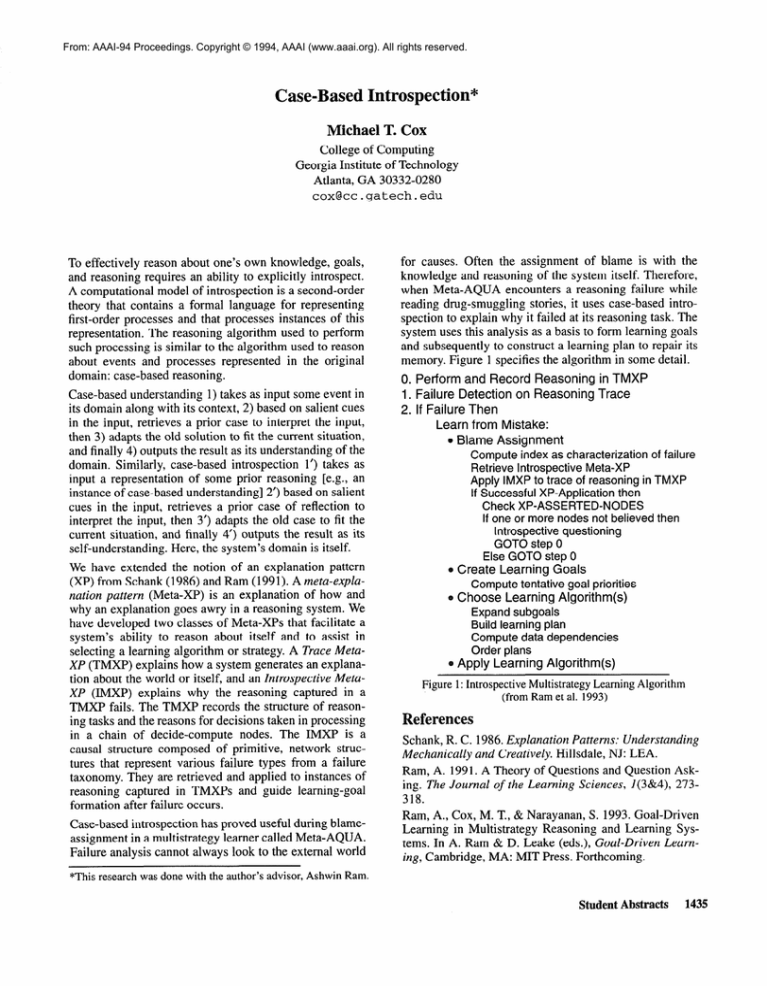
From: AAAI-94 Proceedings. Copyright © 1994, AAAI (www.aaai.org). All rights reserved.
Case-Based Introspection*
Michael T. Cox
College of Computing
Georgia Institute of Technology
Atlanta, GA 30332-0280
cox@cc.gatech.edu
To effectively reason about one’s own knowledge, goals,
and reasoning requires an ability to explicitly introspect.
A computational model of introspection is a second-order
theory that contains a formal language for representing
first-order processes and that processes instances of this
representation. The reasoning algorithm used to perform
such processing is similar to the algorithm used to reason
about events and processes represented in the original
domain: case-based reasoning.
Case-based understanding
1) takes as input some event in
its domain along with its context, 2) based on salient cues
in the input, retrieves a prior case to interpret the input,
then 3) adapts the old solution to fit the current situation,
and finally 4) outputs the result as its understanding of the
domain. Similarly, case-based introspection
1’) takes as
input a representation of some prior reasoning [e.g., an
instance of case-based understanding] 2’) based on salient
cues in the input, retrieves a prior case of reflection to
interpret the input, then 3’) adapts the old case to fit the
current situation, and finally 4’) outputs the result as its
self-understanding.
Here, the system’s domain is itself.
We have extended the notion of an explanation pattern
(XP) from Schank (1986) and Ram (1991). A meta-explanation pattern (Meta-XP) is an explanation of how and
why an explanation goes awry in a reasoning system. We
have developed two classes of Meta-XPs that facilitate a
system’s ability to reason about itself and to assist in
selecting a learning algorithm or strategy. A Trace MetaXP (TMXP) explains how a system generates an explanation about the world or itself, and an Introspective MetaXP (IMXP) explains why the reasoning captured in a
TMXP fails. The TMXP records the structure of reasoning tasks and the reasons for decisions taken in processing
in a chain of decide-compute
nodes. The IMXP is a
causal structure composed of primitive, network structures that represent various failure types from a failure
taxonomy. They are retrieved and applied to instances of
reasoning captured in TMXPs and guide learning-goal
formation after failure occurs.
Case-based introspection has proved useful during blameassignment in a multistrategy learner called Meta-AQUA.
Failure analysis cannot always look to the external world
for causes. Often the assignment of blame is with the
knowledge and reasoning of the system itself. Therefore,
when Meta-AQUA encounters a reasoning failure while
reading drug-smuggling
stories, it uses case-based introspection to explain why it failed at its reasoning task. The
system uses this analysis as a basis to form learning goals
and subsequently to construct a learning plan to repair its
memory. Figure 1 specifies the algorithm in some detail.
0. Perform and Record Reasoning in TMXP
1. Failure Detection on Reasoning Trace
2. If Failure Then
Learn from Mistake:
0 Blame Assignment
Compute index as characterization
of failure
Retrieve Introspective Meta-XP
Apply IMXP to trace of reasoning in TMXP
If Successful XP-Application then
Check XP-ASSERTED-NODES
If one or more nodes not believed then
Introspective questioning
GOT0 step 0
Else GOT0 step 0
0 Create Learning Goals
Compute tentative
goal priorities
0 Choose Learning Algorithm(s)
Expand subgoals
Build learning plan
Compute data dependencies
Order plans
e Apply Learning Algorithm(s)
Figure 1: Introspective Multistrategy Learning Algorithm
(from Ram et al. 1993)
eferences
Schank, R. C. 1986. Explanation Patterns: Understanding
Mechanically and Creatively. Hillsdale, NJ: LEA.
Ram, A. 199 1. A Theory of Questions and Question Asking. The Journal of the Learning Sciences, 1(3&4), 273318.
Ram, A., Cox, M. T., & Narayanan, S. 1993. Goal-Driven
Learning in Multistrategy Reasoning and Learning Systems. In A. Ram & D. Leake (eds.), Goal-Driven Learning, Cambridge, MA: MIT Press. Forthcoming.
*This research was done with the author’s advisor, Ashwin Ram.
Student Abstracts
1435





